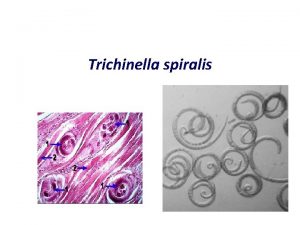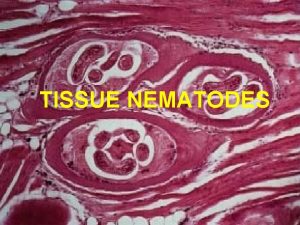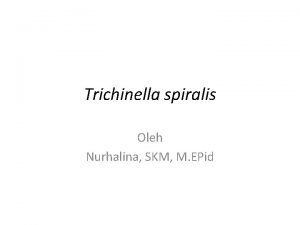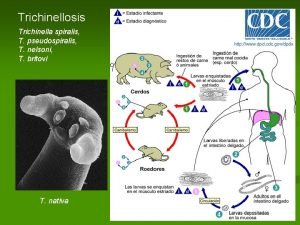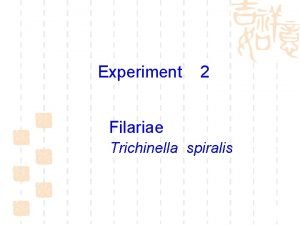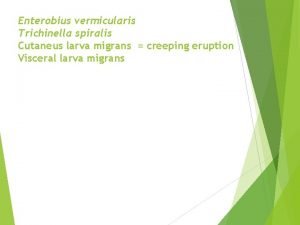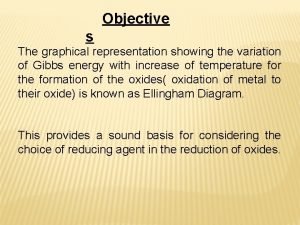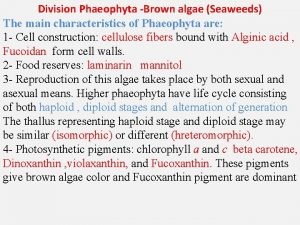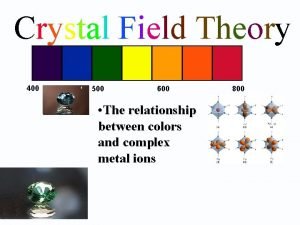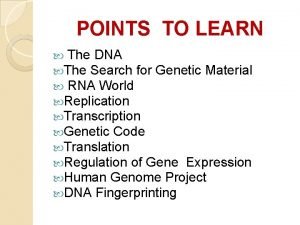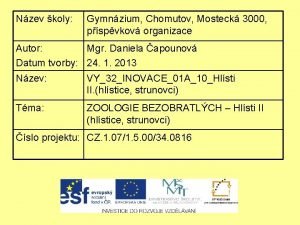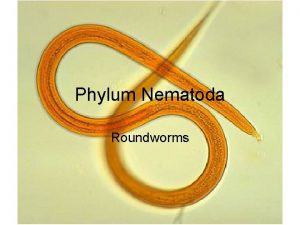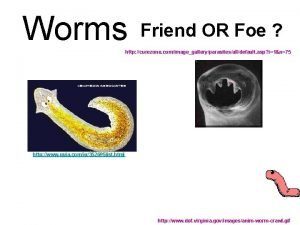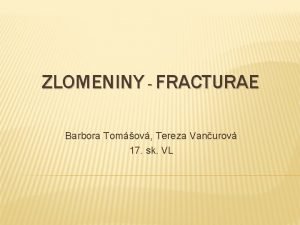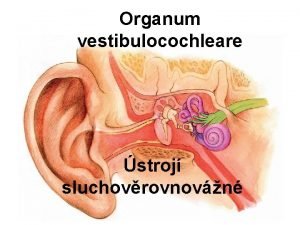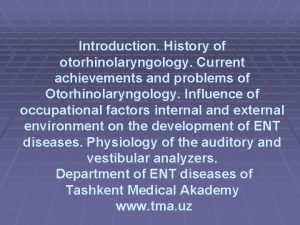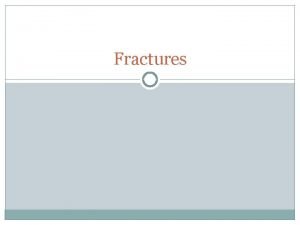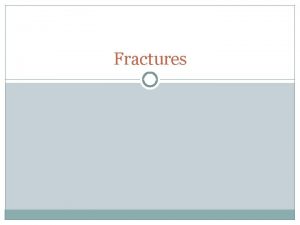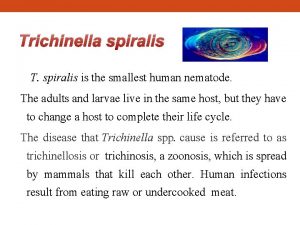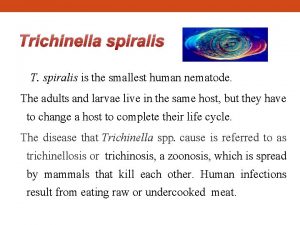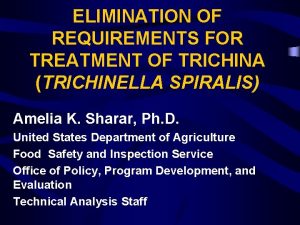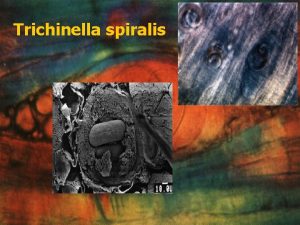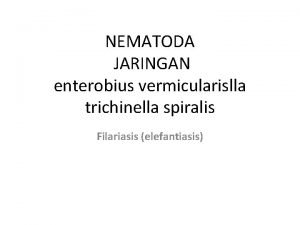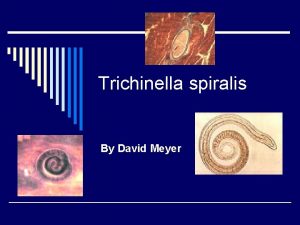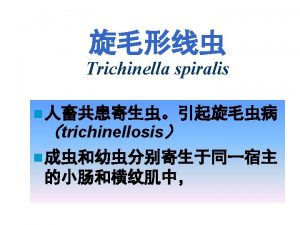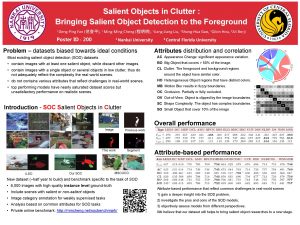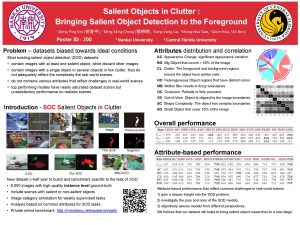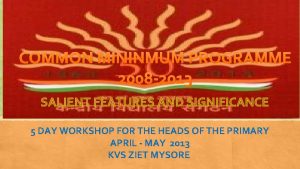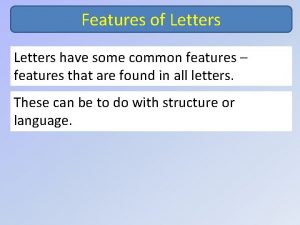Trichinella spiralis SALIENT FEATURES v COMMON NAME Trichina


































- Slides: 34

Trichinella spiralis

SALIENT FEATURES v COMMON NAME: Trichina worm- The Pork worm v Trichinella spiralis means spira, how this coils up in its host v DISEASE: Trichinosis v It is a zoonotic disease v HABITAT: Adult worms-Mucosa of small intestinal Encysted larvae- Striated muscles of hosts v The same animal acts as definitive and intermediated host v Is most common in Europe, North America, and Asia v INFECTIVE STAGE: Contaminated meat (muscle) containing encysted larvae (pig) v DIAGNOSTIC STAGE: Larvae encysted in muscle (human) v Can be fatal if large numbers of cysts form in the heart muscle.

MORPHOLOGY


LARVAE

VIVIPAROUS Expel active larvae

Epidemiology q The disease occurs among pigs, rats & humans q Rats and pigs feeding on garbage that includes infected offal q Dead or dying infected rats are themselves eaten by pigs q Raw or poorly cooked pork (sausage) harboring infective larvae then become the vehicle for human infections q Trichinellosis is a cosmopolitan disease that occurs most commonly in Europe and the US



PATHOGENESIS: Penetration of the adult females into mucosa The first symptoms appear between 1 - 2 days after ingestion The worms migrate in the intestinal epithelium Inflammation of duodenal and jejunal mucosa • • • This causes: INFLAMMATION NAUSEA VOMITING SWEATING DIARRHEA

The migrating larvae Ten days after infection the larvae will penetrate the muscle fibers & other parts of the body. • Muscular pain • Difficulty breathing • • Per orbital edema and conjunctivitis Heart (Myocarditis) Lungs (Pneumonitis) Brain (Encephalitis) – Can be fatal if large numbers of cysts form in the heart muscle. – Heart failure or respiratory or kidney malfunction

DIAGNOSIS : q Muscle biopsy at the encystment stage q Blood test for eosinophilia q Increased levels of creatine phosphokinase (CPK) q Serology test Immunoassays, such as ELISA q At the diarrheal stage, adult and larvae may be found in faeces

TREATMENT ü THIABENDAZOLE ü MEBENDAZOLE ü CORTICOSTEROIDS


Trichuris trichiura Whip worm

Trichuris trichiura Common name: whip worm Disease: trichuriasis, whip worm infection Final host: human, dogs, pig, monkey Habitat: large intestinal ( cecum, appendix, rectum) Geographical distribution: Cosmopolitan with poor sanitation. Children are more likely to be infected than adults because they are more likely to have close physical contact with contaminated soil q Infective stage: infective larva in egg q Transmission occurs through ingestion of eggs, usually on contaminated vegetables or soil. q Diagnostic stage: Egg barrel shape with polar plugs q q q

Morphology: Adult female worm: The anterior two-thirds of the body being very thin (looks like a whip) and the remaining posterior end is thick and linear. Size: 3. 5 -5 cm in length Adult Male worm: smaller than the female, 3. 0 -3. 5 cm. The posterior end is curved and has a single spicule enveloped with sheath.

q The anterior end two-thirds of the body being very thin (looks like a whip). q Adult worm penetrates into and embed its whip-like anterior portion in the intestinal mucosa, By small spear Adult female -Longer than the male. - posterior end is thick and linear. Adult male -Shorter than the female. posterior end curved and -has a single spicule enveloped with sheath. .

posterior end curved and has a single spicule enveloped with sheath

Eggs: Shape: barrel–shaped Size: 50 -55 x 25 -30μm Shell: thick egg shell with 2 polar plugs Color: Yellow-brown Content: immature egg cells 3000 -10000 eggs daily output



Life cycle: • Eggs pass out immature • Embryo develops inside the egg (that takes about 3 weeks at 25 C) • Mature eggs swallowed 1 st stage larvae hatch in small intestine and penetrate villi • Then migrate to large intestine and attach to mucosa with the thin anterior end • After 2 -4 month females mature and lay eggs.





Pathology: Light infection with Trichiuris are asymptomatic Heavier infections are characterized by 1 - diarrhea, 2 - anorexia, 3 - nausea 4 - abdominal pain 5 - anemia may be the result of hemorrhaging when the worms mucosal damage)(penetrate the intestinal wall Rectal prolapse. Children’s infection cause rectal prolapse, The reason is the cecum is damaged by the worm, the cecum can be pushed out from the anus.

Prolapsed Rectum

Laboratory diagnosis 1 - Eggs or worm in feces. Eggs are oval, barrel shaped, 2 - Eosinophilia may occur. 3 - In heavy infection proctoscopy or sigmoidoscopy, can show the worms attached to the mucosa. 4 - Visual detection of adult worms on prolapsed rectum.




 Common name of trichinella spiralis
Common name of trichinella spiralis Trichinella spiralis common name
Trichinella spiralis common name Trichinella spiralis
Trichinella spiralis Trichinella spiralis yaşam döngüsü
Trichinella spiralis yaşam döngüsü Trichinella spiralis distribucion geografica
Trichinella spiralis distribucion geografica Trichinella spiralis
Trichinella spiralis Trichinella spiralis morphology
Trichinella spiralis morphology Trichina worm
Trichina worm Ceftrioxone
Ceftrioxone Salient features of unix operating system
Salient features of unix operating system Salient features of income tax act 1961
Salient features of income tax act 1961 Salient features of ellingham diagram
Salient features of ellingham diagram Salient features of operation blackboard
Salient features of operation blackboard Salient features of ndps act 1985
Salient features of ndps act 1985 General characteristics of phaeophyta
General characteristics of phaeophyta Salient features of crystal field theory
Salient features of crystal field theory Salient features of objective resolution
Salient features of objective resolution Aspects of victorian novel
Aspects of victorian novel Salient features of right to education act 2009
Salient features of right to education act 2009 What are the salient features of agency
What are the salient features of agency Salient features of quantum free electron theory
Salient features of quantum free electron theory Fema 1999 objectives
Fema 1999 objectives Cb drrm
Cb drrm Victorian age summary
Victorian age summary Salient features of genetic code
Salient features of genetic code What is a constitution?
What is a constitution? Trichinella
Trichinella Trichinella worm
Trichinella worm Guinea worm
Guinea worm Fractura impressiva
Fractura impressiva Lamina propria
Lamina propria Organum vestibulocochleare
Organum vestibulocochleare Canalis spiralis divided into 2 part:
Canalis spiralis divided into 2 part: Fractura aperta complicada
Fractura aperta complicada Fractura spiralis
Fractura spiralis
